|
|
|
Sort Order |
|
|
|
Items / Page
|
|
|
|
|
|
|
| Srl | Item |
| 1 |
ID:
124766
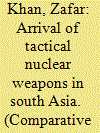

|
|
|
|
|
| Publication |
2013.
|
| Summary/Abstract |
This article examines the arrival of Tactical Nuclear Weapons (TNWs) amid the rapid arms race in South Asia. It analyzes the stability and instability prospects linked to the arrival of and dependence on TNWs. It states that TNW is a murky term that confronts a definitional issue. Although TNW has not been used yet, it entails the risk of its use on the battlefield in the event of a limited war. Conceptually, this sets the stage for an interesting debate on whether or not the arrival of TNWs is stabilizing for the South Asian region, which has confronted many wars and minor border skirmishes during pre- and post-nuclear periods. Since it is viewed that a possible limited military escalation to a nuclear level may not be ruled out and the arrival of TNWs has become a reality, the article concludes that a centralized command and control system bolstered with the non-deployed deterring posture of TNWs is the immediate solution to avert the related worries of pre-delegation, force protection, and the use-or-lose dilemma. It is expected that, learning from their nuclear predecessors, the South Asian nuclear leadership would practice restraint, remain rational, and call for the need of political trust and military reassurances to avert nuclear weapon use.
|
|
|
|
|
|
|
|
|
|
|
|
|
|
|
|
| 2 |
ID:
116300
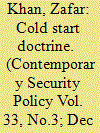

|
|
|
|
|
| Publication |
2012.
|
| Summary/Abstract |
A reaction by the Indian military to a series of violent crises with Pakistan, beginning with the Kargil conflict of 1999, Cold Start Doctrine (CSD) envisions limited attacks on Pakistan territory as non-nuclear retaliation against asymmetric and proxy attacks. Cold Start Doctrine and Pakistani responses show that the South Asian region is still adjusting to the consequences of overt nuclearization in 1998. India and Pakistan remain prone to arms racing and vulnerable to destablization. CSD is part of an action-reaction process, increasing risks of war and the risk that nuclear weapons would be used should war occur. It worsens the natural tension between India's desire for resolution through conventional conflict and Pakistan's declared willingness to escalate to nuclear first use. For India, CSD increases incentives to abandon its previous commitment to nuclear No First Use. Probable Pakistani responses include development of tactical nuclear weapons, forward deployment of nuclear forces, and pre-delegation of launch authority, increasing its problems of force protection, command and control, and escalation control. This article concludes, based on reliable sources, that neither of these war-like strategies benefits the two nuclear rivals as each state's policy options confront certain issues that invite strategic instability in South Asian region and should be reconsidered.
|
|
|
|
|
|
|
|
|
|
|
|
|
|
|
|
| 3 |
ID:
147957
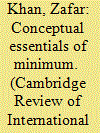

|
|
|
|
|
| Summary/Abstract |
Very little is known about Pakistan's nuclear policy and, in particular, about its adoption of minimum deterrence, given the existence of nuclear ambiguity and the absence of public, official documentation of Pakistan's understanding of minimum deterrence. Therefore, despite its innocuousness, ‘minimum’ remains a vague and complex phenomenon short of definitional concreteness when it is brought to a real conceptual test. On the one hand, minimum is regarded as a small number of deterrent forces arguing against expansion and arms competition, while, on the other hand, it is viewed as a relative, and therefore continually evolving, concept depending on the region's fast-changing strategic environment. A conceptual basis for the concept of minimum is explored, leading to the question: why does Pakistan pursue minimum deterrence? It traces out the rationale of Pakistan's minimum deterrence as conceptualized following the 1998 nuclear tests. This rationale of Pakistan's minimum deterrence is then analysed in light of the essentials of minimum deterrence in order to see whether it is consistent with the basics of minimum as conceived here.
|
|
|
|
|
|
|
|
|
|
|
|
|
|
|
|
| 4 |
ID:
153396
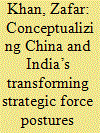

|
|
|
|
|
| Summary/Abstract |
As China and India gradually rise and become the centre point of world politics in the 21st century, both these nuclear states tend to transform their strategic force postures to hide their vulnerabilities and ensure the credibility of their deterrence force. This article conceptualizes the gradual transformation of China and India’s strategic force postures under the essentials of minimum deterrence. In doing so, it examines the conceptualization of minimum deterrence, doctrinal use of deterrent forces and the modernization of strategic forces, though the perceptional aspects of these three imperatives may differ between these two nuclear states. This article attempts to find out whether or not these strategic imperatives, in relation to their transformation of strategic force postures, are consistent with the essentials of minimum deterrence conceived here. This article concludes that if China and India’s deterrence force modernization falls within these essential categories (i.e. modernization, accuracy, upgrades, correcting ranges, credibility, penetrability, survivability), they may be consistent with minimum deterrence. Alternatively, if both China and India go beyond the minimum deterrence that they initially conceptualized, this may remain inconsistent with the minimum deterrence conceptualized here.
|
|
|
|
|
|
|
|
|
|
|
|
|
|
|
|
| 5 |
ID:
175703
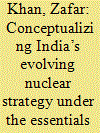

|
|
|
|
|
| Summary/Abstract |
As India intends to complete its ambitious deterrent force projects such as the development of Ballistic Missile Defense (BMD) system, Intercontinental Ballistic Missiles (ICBMs), Multiple Independently Reentry Vehicles (MIRVs), nuclear powered submarines, aircraft carrier, and a number of nuclear reactors as part of its would-be modified Draft Nuclear Doctrine (DND), it is imperative to analyze whether or not India’s shift in its deterrent force posture including that of ambitious deterrent force projects remains consistent with minimum deterrence India earlier conceptualized. This article conceptualizes the rationale of India’s evolving nuclear strategy under the conceptual essentials of minimum deterrence and the limitations to and challenges of India’s ambitious deterrence force posture. Also, the article explores the key factors how and why India might be shifting away from its deterrent force posturing it earlier conceived. However, this article finds that India may not remain consistent with its broader nuclear policy of minimum deterrence conceptualized in its earlier nuclear drafts if it continues to successfully develop these mega deterrent force projects bolstered by sophisticated delivery systems amidst India’s increasing strategic partnership with the US.
|
|
|
|
|
|
|
|
|
|
|
|
|
|
|
|
| 6 |
ID:
156281
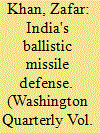

|
|
|
| 7 |
ID:
144404
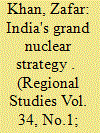

|
|
|
| 8 |
ID:
193522
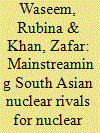

|
|
|
|
|
| Summary/Abstract |
There is a need for mainstreaming South Asian Non-NPT Nuclear Weapon States. India is an emerging market and Pakistan has the potential to become a future market for nuclear energy. Furthermore, they have nuclear weapons, making it important to take them on board in the Nuclear Nonproliferation Regime (NPR). Given the reality that they are not ready to roll back their nuclear program, there is a need to explore options for mainstreaming them especially in nuclear export control mechanisms. This article investigates the policy imperatives for the international community to address the South Asian Non-NPT-NWSs in the NSG.
|
|
|
|
|
|
|
|
|
|
|
|
|
|
|
|
| 9 |
ID:
128018
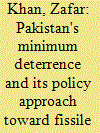

|
|
|
|
|
| Publication |
2014.
|
| Summary/Abstract |
In the immediate aftermath of nuclear weapon tests in May 1998, Pakistan opted
for a policy of minimum deterrence, which entailed that Pakistan would not need
a larger number of nuclear deterrent forces, as a small number of them would be
sufficient to deter. The concept of a minimum deterrence existed even before
Pakistan tested nuclear weapons. However, later Islamabad realized that minimum
could not be sustained as earlier conceptualized. It needed to be evolving and
dynamic. Minimum deterrence (MD) transformed into minimum credible deterrence
(MCD) which had policy implications for Pakistan's force-building structure.
Among its force building, Pakistan not only upgrades its deterrent forces, but also
builds more nuclear reactors which makes Islamabad reluctant to withdraw its
veto from the Fissile Material Cut-off Treaty (FMCT). It requires more fissile
materials in order to enhance its deterrent credibility. Why does Islamabad do
this, and if its policy approach remains consistent with the minimum deterrence it
conceptualized earlier? This article examines the rudimentary factors that increase
Pakistan's security concerns and elaborates on Pakistan's post-1998 shifting policy
approach toward fissile materials in the region's changed strategic environment.
|
|
|
|
|
|
|
|
|
|
|
|
|
|
|
|
| 10 |
ID:
136879
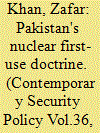

|
|
|
|
|
| Summary/Abstract |
A close look at the literature on Pakistan's nuclear weapons doctrine reveals the ambiguity in Pakistan's nuclear-use options. Pakistani officials and commentators leave open the possibility that Pakistan would use its nuclear weapon first, but it is not clear when, where, or how it would. Others conclude that Islamabad would use its nuclear weapon only as a last resort, but that condition too remains vague. This article examines the puzzle of Pakistan's nuclear weapons use, demonstrating that ambiguity plays a central role in Pakistan's nuclear weapons policy, much as nuclear ambiguity exists in each nuclear weapons state's policy. This article departs from previous research and commentary on Pakistan's nuclear doctrine by introducing the thesis that Pakistan's nuclear ambiguity is real, but far from internationally unique. Pakistan, like the USA at the onset of the nuclear era, relies on nuclear weapons for survival. The development of Pakistan's forces, including tactical nuclear weapons, suggests an emphasis on counterforce targeting. The role of domestic political processes, the civil–military dilemma and its impact on strategic policy in Pakistan, have received considerable attention, but still require untangling. Progress towards no first use probably requires changes to the conventional balance in South Asia, and stronger democratic, civilian rule in Pakistan, free of direct intervention from the army. Finally, global dynamics shaping the salience of nuclear weapons globally cannot be disregarded in any assessment of South Asian and Pakistani dynamics.
|
|
|
|
|
|
|
|
|
|
|
|
|
|
|
|
| 11 |
ID:
119749
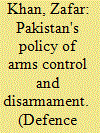

|
|
|
|
|
| Publication |
2013.
|
| Summary/Abstract |
This article is toevaluate Pakista's role in global arms control and disarmament. It discusses how Pakistan supported the international disarmament process and why it later shifted its perception for acquiring nuclear weapons. Also, it broadly analyses Pakistan's concerns about then arms control and disarmament process both at the international and regional level. The author considers that these conserns became the hurdles that keep the two nuclear rivals of South Asia away from the creation of Arms Control Regime (ACR) needed for strategic stability and the security of armed forces in the South Asian region.
Practically, the ACR does not exist in the South Asian strategic environment. This article is a call to address certain tangible and intangible variables which hinder the process of creation of an ACR.
|
|
|
|
|
|
|
|
|
|
|
|
|
|
|
|
| 12 |
ID:
119275
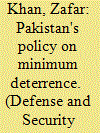

|
|
|
|
|
| Publication |
2013.
|
| Summary/Abstract |
This article focuses on Pakistan's policy option of "minimum deterrence" (MD) post-1998 nuclearization of South Asia and explores why "minimum" in reality is not the minimum. It states that the term "minimum" has not been fully defined yet due to which MD stays ambiguous. In addition, it endeavors to elaborate the rudimentary factors responsible for the non-existence of an MD, which, in turn, keeps the Pakistani stance on MD dynamic and evolving.
|
|
|
|
|
|
|
|
|
|
|
|
|
|
|
|
| 13 |
ID:
145766
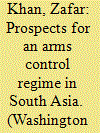

|
|
|
|
|
| Summary/Abstract |
There have been several confidence-building measures (CBMs) between India and Pakistan in both the pre- and post-nuclear periods. There was even a proposal to create a strategic restraint regime, whereby both India and Pakistan could eventually create institutions that could avoid the crises triggering conventional and nuclear conflict. However, these CBMs have failed to produce promising results because of enduring interstate rivalry between the two countries, and have played little or no role in sustaining peace and strategic stability in South Asia. The Kargil conflict of 1999, the common border confrontation in 2001–2002 on the Line of Control, and the Mumbai terror attack in 2008 (attributed to a Pakistani group) all highlight the enduring standoff between the two states.
|
|
|
|
|
|
|
|
|
|
|
|
|
|
|
|
| 14 |
ID:
174180
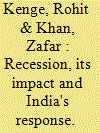

|
|
|
|
|
| Summary/Abstract |
Rohit Kenge and Zafar Khan delve into the concept of recession to understand the current dynamics of the Indian economy. They examine why the 2008–09 recession had a lesser impact on India whereas the 2019–20 one has had a high impact. They put forth a strategy for reducing the effects of the current recession and also analyse it as a business opportunity for exploring new arenas.
|
|
|
|
|
|
|
|
|
|
|
|
|
|
|
|
| 15 |
ID:
147398
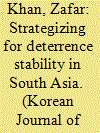

|
|
|
|
|
| Summary/Abstract |
Before the arrival of nuclear weapons in South Asia, both India and Pakistan had fought several wars. The arrival of nuclear weapons has made both the South Asian nuclear weapons states more cautious to fight. This caution and restraint is directly associated with the fear of using nuclear weapons, the damage of which remains unacceptable to both the adversaries. Although nuclear weapons are considered for deterrence purposes and they are assumed to provide deterrence stability, they are not a guaranteed panacea for all the outstanding issues including the core issue of Kashmir. This absence of a guaranteed solution for these problems despite the presence of nuclear weapons entails the deterrence instability in South Asia, even though neither India nor Pakistan are directly fighting anymore because of the fear of major military escalation to a nuclear use. This paper talks about at least three major dynamics associated with nuclear weapons that might help promote deterrence stability in South Asia. It asks for the consistent practice of minimum deterrence that was initially conceptualized, focuses on the practices of defensive doctrinal postures between India and Pakistan, and calls for an arms control regime (ACR) that does not yet exist in South Asia. In addition to other peaceful measures discussed in the existing literature, the amalgamation of these three ingredients and the commonalities within them could play an important role in promoting deterrence stability in South Asia.
|
|
|
|
|
|
|
|
|
|
|
|
|
|
|
|
|
|
|
|
|